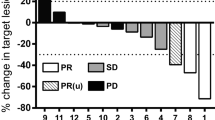Abstract
Subcutaneous panniculitis-like T-cell lymphoma (SPTCL) is a rare lymphoma. The optimal therapy for SPTCL is undefined and the results of treatment with anthracycline-containing chemotherapy for aggressive cases have remained poor. A 27-year-old woman with multifocal and aggressive CD8+ SPTCL was treated with the purine analog fludarabine in combination with mitoxantrone and dexamethasone (FND). The patient achieved complete remission after one course of treatment. After completion of six courses of FND, the patient has remained in remission for more than 3 years. FND may be an effective treatment for aggressive SPTCL.


Similar content being viewed by others
References
Jaffe ES, Ralfkiaer E. Subcutaneous panniculitis-like T cell lymphoma. In: Jaffe ES, Harris NL, Stein H, editors. Tumours of haematopoietic and lymphoid tissues. Lyon: IARC Press, 2001: 212–3
Go RS, Wester SM. Immunophenotypic and molecular features, clinical outcomes, treatments, and prognostic factors associated with subcutaneous panniculitis- like T-cell lymphoma: a systematic analysis of 156 patients reported in the literature. Cancer 2004; 101: 1404–13
Kwong YL, Wong KF. Association of pure red cell aplasia with T large granular lymphocyte leukaemia. J Clin Pathol 1998; 51: 672–5
Au WY, Shek WH, Nicholls J, et al. T-cell intravascular lymphomatosis (angio-tropic large cell lymphoma): association with Epstein-Barr viral infection. Histopathology 1997; 31: 563–7
Willemze R, Jaffe ES, Burg G, et al. WHO-EORTC classification for cutaneous lymphomas. Blood 2005; 105: 3768–85
Craig AJ, Cualing H, Thomas G, et al. Cytophagic histiocytic panniculitis: a syndrome associated with benign and malignant panniculitis: case comparison and review of the literature. J Am Acad Dermatol 1998; 39: 721–36
Salhany KE, Macon WR, et al. Subcutaneous panniculitis-like T-cell lymphoma: clinicopathologic, immunophenotypic, and genotypic analysis of alpha/beta and gamma/delta subtypes. Am J Surg Pathol 1998; 22: 881–93
Ghobrial IM, Weenig RH, Pittlekow MR, et al. Clinical outcome of patients with subcutaneous panniculitis-like T-cell lymphoma. Leuk Lymphoma 2005; 46: 703–8
Tsukamoto Y, Katsunobu Y, Omura Y, et al. Subcutaneous panniculitis-like T-cell lymphoma: successful initial treatment with prednisolone and cyclosporin A. Intern Med 2006; 45: 21–4
Elter T, Hallek M, Engert A. Fludarabine in chronic lymphocytic leukaemia. Expert Opin Pharmacother 2006; 7: 1641–51
Au WY, Ng WM, Choy C, et al. Aggressive subcutaneous panniculitis-like T-cell lymphoma: complete remission with fludarabine, mitoxantrone and dexamethasone. Br J Dermatol 2000; 143: 408–10
Przybylski GK, Wu H, Macon WR, et al. Hepatosplenic and subcutaneous panniculitis-like gamma/delta T cell lymphomas are derived from different Vdelta subsets of gamma/delta T lymphocytes. J Mol Diagn 2000; 2: 11–9
Go RS, Gazelka H, Hogan JD, et al. Subcutaneous panniculitis-like T-cell lymphoma: complete remission with fludarabine. Ann Hematol 2003; 82: 247–50
Wells J, Kosky CA, Scolyer RA, et al. Unusual case of subcutaneous panniculitis-like T-cell lymphoma. Australas J Dermatol 2004; 45: 114–8
Acknowledgments
No sources of funding were used to assist in the preparation of this case report. The authors have no conflicts of interest that are directly relevant to the content of this case report.
Author information
Authors and Affiliations
Corresponding author
Rights and permissions
About this article
Cite this article
Chim, CS., Loong, F., Ng, WK. et al. Use of Fludarabine-Containing Chemotherapeutic Regimen Results in Durable Complete Remission of Subcutaneous Panniculitis-Like T-Cell Lymphoma. Am J Clin Dermatol 9, 396–398 (2008). https://doi.org/10.2165/0128071-200809060-00007
Published:
Issue Date:
DOI: https://doi.org/10.2165/0128071-200809060-00007




